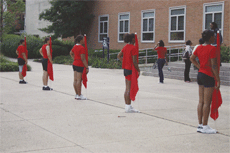 |
 |
 |
|
|
|||||||||||||
|
|
|||||||||||||
| Email Article | Printable Page |
Natural Hair Not Wanted
 |
|
Photo credit: Jordan Colbert/The Hilltop
Tryouts took place in the Main Yard at Howard University.
|
Howard University's tryouts for cheerleading, band and the Ohh-laa-laa dance squad have ended with allegations of discrimination based on hair, body type and criteria other than talent.
"They went around basically telling everyone their imperfections, saying you would have to shave your legs, wax your eyebrows . . ." said one "flashy flags" contender who allegedly received comments from the coordinator about her short, natural hair.
"Hmm -- I don't know what we would do with your hair if you were chosen for the team," coordinator Lauren White said, according to the trainee. Another leader suggested an instant weave.
"The band has to be uniform in terms of looks as well as performance," said band director John Newson. "It does not matter what they do with their hair all year round, but when it is time to perform," straight hair "is the requirement."
For some students, such as band member Marcus Ware, assimilation is an important part of the organization.
"The band requires unity in all aspects, so if someone does not fit that requirement, they would just stand out," Ware said.
However, the forced uniformity does not sit well with others.
"This perpetuates stereotyping in our society [for people] of the African descent and we should allow all types of persons to take part in this activity," said Debra Roberts, a psychology professor.
Band Director Newson's assertion that "relaxed hair is my preference as well as everyone else's" leaves many begging to differ, including acting major Atrice Williams, a sophomore.
"I would think nothing of seeing someone with natural hair actually performing on the flashy flag wavers," Williams said. "I see many of the beautiful black women on the HU campus rocking the natural look, and the style is so common it might be weird not to see that on the squad."
A current flag squad member who requested anonymity said, "It was decided that we should all have straight hair during performances and we don't have a problem with it. It has nothing to do with changing your identity, but just being uniform in appearance."
White, the coordinator, was asked about a heavy student who tried out for the band and said she was shown a size "large" that was too small for her. The student, Shalondra Gardner, said she was given the choice of wearing it or losing weight.
"Being a full-figured woman, I know how it feels to be stereotyped," White said. "I showed them all the three sizes of the uniform, making it clear that it was pre-ordered and this was the requirement. I would never pressure someone to lose weight. The decision was hers and she was welcome to come to practice."
White also said that her statements to the "flashy flags" contender about hair were misinterpreted. She said she told tryouts that the band requires uniformity in all aspects, so that for performances everyone is required to have straight hair. If the tryout were chosen, she would have to put in an instant weave or a wig piece. It was not said in a downgrading way, White said, maintaining that the school was not trying to influence personal hair choices.
Newson denied size discrimination in the band's dance groups, saying the reality was that uniforms are French cut and must be worn tastefully.
Posted Oct. 4, 2004
In Student Life
Dissatisfied With School's Response, Howard Student Starts Rape Awareness Group
Guess Who Else Is Reading Those "Facebook" Entries?
Common-Sense Tips for Managing Student Debt
Students Recover Emotionally, Physically from After-Party Shooting
| Home | News | Sports | Culture | Voices | Images | Projects | About Us Copyright © 2006 Black College Wire. Black College Wire is a project of the Black College Communication Association and has partnerships with The National Association of Black Journalists and the Robert C. Maynard Institute for Journalism Education. |